I'm attempting to implement a performant Gaussian blur taking advantage of the fact that a Gaussian kernel is separable, i. e. you can express a 2D convolution as a combination of two 1D convolutions.
I'm able to generate two kernels which I believe are correct using the following code.
/// <summary>
/// Create a 1 dimensional Gaussian kernel using the Gaussian G(x) function
/// </summary>
/// <param name="horizontal">Whether to calculate a horizontal kernel.</param>
/// <returns>The <see cref="T:float[,]"/></returns>
private float[,] CreateGaussianKernel(bool horizontal)
{
int size = this.kernelSize;
float[,] kernel = horizontal ? new float[1, size] : new float[size, 1];
float sum = 0.0f;
float midpoint = (size - 1) / 2f;
for (int i = 0; i < size; i++)
{
float x = i - midpoint;
float gx = this.Gaussian(x);
sum += gx;
if (horizontal)
{
kernel[0, i] = gx;
}
else
{
kernel[i, 0] = gx;
}
}
// Normalise kernel so that the sum of all weights equals 1
if (horizontal)
{
for (int i = 0; i < size; i++)
{
kernel[0, i] = kernel[0, i] / sum;
}
}
else
{
for (int i = 0; i < size; i++)
{
kernel[i, 0] = kernel[i, 0] / sum;
}
}
return kernel;
}
/// <summary>
/// Implementation of 1D Gaussian G(x) function
/// </summary>
/// <param name="x">The x provided to G(x)</param>
/// <returns>The Gaussian G(x)</returns>
private float Gaussian(float x)
{
const float Numerator = 1.0f;
float deviation = this.sigma;
float denominator = (float)(Math.Sqrt(2 * Math.PI) * deviation);
float exponentNumerator = -x * x;
float exponentDenominator = (float)(2 * Math.Pow(deviation, 2));
float left = Numerator / denominator;
float right = (float)Math.Exp(exponentNumerator / exponentDenominator);
return left * right;
}
The kernel size is calculated from the sigma as follows.
this.kernelSize = ((int)Math.Ceiling(sigma) * 2) + 1;
this.sigma = sigma;
Given a sigma of 3 This yields the following in each direction.
0.106288522,
0.140321344,
0.165770069,
0.175240144,
0.165770069,
0.140321344,
0.106288522
Which sums up to 1 perfectly so I'm in the right path.
Applying the kernels against an image is proving to be difficult as something is going wrong though I'm not sure what.
I'm using the following code which to run a 2-pass algorithm which works perfectly when convolving kernels that are even in both directions like Sobel or Prewitt for edge detection.
protected override void Apply(ImageBase target,
ImageBase source,
Rectangle targetRectangle,
Rectangle sourceRectangle,
int startY,
int endY)
{
float[,] kernelX = this.KernelX;
float[,] kernelY = this.KernelY;
int kernelYHeight = kernelY.GetLength(0);
int kernelYWidth = kernelY.GetLength(1);
int kernelXHeight = kernelX.GetLength(0);
int kernelXWidth = kernelX.GetLength(1);
int radiusY = kernelYHeight >> 1;
int radiusX = kernelXWidth >> 1;
int sourceY = sourceRectangle.Y;
int sourceBottom = sourceRectangle.Bottom;
int startX = sourceRectangle.X;
int endX = sourceRectangle.Right;
int maxY = sourceBottom - 1;
int maxX = endX - 1;
Parallel.For(
startY,
endY,
y =>
{
if (y >= sourceY && y < sourceBottom)
{
for (int x = startX; x < endX; x++)
{
float rX = 0;
float gX = 0;
float bX = 0;
float rY = 0;
float gY = 0;
float bY = 0;
// Apply each matrix multiplier to the
// color components for each pixel.
for (int fy = 0; fy < kernelYHeight; fy++)
{
int fyr = fy - radiusY;
int offsetY = y + fyr;
offsetY = offsetY.Clamp(0, maxY);
for (int fx = 0; fx < kernelXWidth; fx++)
{
int fxr = fx - radiusX;
int offsetX = x + fxr;
offsetX = offsetX.Clamp(0, maxX);
Color currentColor = source[offsetX, offsetY];
float r = currentColor.R;
float g = currentColor.G;
float b = currentColor.B;
if (fy < kernelXHeight)
{
rX += kernelX[fy, fx] * r;
gX += kernelX[fy, fx] * g;
bX += kernelX[fy, fx] * b;
}
if (fx < kernelYWidth)
{
rY += kernelY[fy, fx] * r;
gY += kernelY[fy, fx] * g;
bY += kernelY[fy, fx] * b;
}
}
}
float red = (float)Math.Sqrt((rX * rX) + (rY * rY));
float green = (float)Math.Sqrt((gX * gX) + (gY * gY));
float blue = (float)Math.Sqrt((bX * bX) + (bY * bY));
Color targetColor = target[x, y];
target[x, y] = new Color(red,
green, blue, targetColor.A);
}
}
});
}
Here's the input image:
And here's the image with an attempted blur using 3 sigma.
As you can see something is amiss. It's like I'm sampling from the wrong point or something.
Any ideas? I appreciate that this is a long winded question.
Update
So on the suggestion of Nico Schertler I have split the algorithm into two passes as follows:
protected override void Apply(
ImageBase target,
ImageBase source,
Rectangle targetRectangle,
Rectangle sourceRectangle,
int startY,
int endY)
{
float[,] kernelX = this.KernelX;
float[,] kernelY = this.KernelY;
int kernelXHeight = kernelX.GetLength(0);
int kernelXWidth = kernelX.GetLength(1);
int kernelYHeight = kernelY.GetLength(0);
int kernelYWidth = kernelY.GetLength(1);
int radiusXy = kernelXHeight >> 1;
int radiusXx = kernelXWidth >> 1;
int radiusYy = kernelYHeight >> 1;
int radiusYx = kernelYWidth >> 1;
int sourceY = sourceRectangle.Y;
int sourceBottom = sourceRectangle.Bottom;
int startX = sourceRectangle.X;
int endX = sourceRectangle.Right;
int maxY = sourceBottom - 1;
int maxX = endX - 1;
// Horizontal blur
Parallel.For(
startY,
endY,
y =>
{
if (y >= sourceY && y < sourceBottom)
{
for (int x = startX; x < endX; x++)
{
float rX = 0;
float gX = 0;
float bX = 0;
// Apply each matrix multiplier to the color
// components for each pixel.
for (int fy = 0; fy < kernelXHeight; fy++)
{
int fyr = fy - radiusXy;
int offsetY = y + fyr;
offsetY = offsetY.Clamp(0, maxY);
for (int fx = 0; fx < kernelXWidth; fx++)
{
int fxr = fx - radiusXx;
int offsetX = x + fxr;
offsetX = offsetX.Clamp(0, maxX);
Color currentColor = source[offsetX, offsetY];
float r = currentColor.R;
float g = currentColor.G;
float b = currentColor.B;
rX += kernelX[fy, fx] * r;
gX += kernelX[fy, fx] * g;
bX += kernelX[fy, fx] * b;
}
}
float red = rX;
float green = gX;
float blue = bX;
Color targetColor = target[x, y];
target[x, y] = new Color(red, green, blue, targetColor.A);
}
}
});
// Vertical blur
Parallel.For(
startY,
endY,
y =>
{
if (y >= sourceY && y < sourceBottom)
{
for (int x = startX; x < endX; x++)
{
float rY = 0;
float gY = 0;
float bY = 0;
// Apply each matrix multiplier to the
// color components for each pixel.
for (int fy = 0; fy < kernelYHeight; fy++)
{
int fyr = fy - radiusYy;
int offsetY = y + fyr;
offsetY = offsetY.Clamp(0, maxY);
for (int fx = 0; fx < kernelYWidth; fx++)
{
int fxr = fx - radiusYx;
int offsetX = x + fxr;
offsetX = offsetX.Clamp(0, maxX);
Color currentColor = source[offsetX, offsetY];
float r = currentColor.R;
float g = currentColor.G;
float b = currentColor.B;
rY += kernelY[fy, fx] * r;
gY += kernelY[fy, fx] * g;
bY += kernelY[fy, fx] * b;
}
}
float red = rY;
float green = gY;
float blue = bY;
Color targetColor = target[x, y];
target[x, y] = new Color(red, green, blue, targetColor.A);
}
}
});
}
I'm getting closer to my goal as there is now a blurring effect. Unfortunately it is not correct.
If you look closely you will see that there is double banding in the vertical direction and not enough blur in the horizontal. The following images demonstrate that clearly when I bump up the sigma to 10.
Any assistant would be great.






